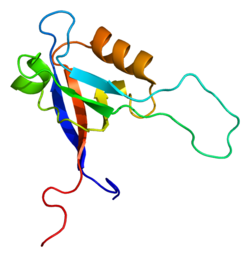- PDZRN3
-
PDZ domain containing RING finger 3 
PDB rendering based on 1uhp.Available structures PDB 1UHP, 1WH1 Identifiers Symbols PDZRN3; LNX3; SEMACAP3 External IDs OMIM: 609729 MGI: 1933157 HomoloGene: 10328 GeneCards: PDZRN3 Gene Gene Ontology Molecular function • ubiquitin-protein ligase activity
• zinc ion binding
• ligase activity
• metal ion bindingCellular component • neuromuscular junction Biological process • neuromuscular junction development
• protein ubiquitinationSources: Amigo / QuickGO RNA expression pattern 
More reference expression data Orthologs Species Human Mouse Entrez 23024 55983 Ensembl ENSG00000121440 ENSMUSG00000035357 UniProt Q9UPQ7 Q3UPS8 RefSeq (mRNA) XM_001133042 NM_018884.2 RefSeq (protein) XP_001133042 NP_061372.2 Location (UCSC) Chr 3:
73.43 – 73.67 MbChr 6:
101.1 – 101.33 MbPubMed search [1] [2] PDZ domain-containing RING finger protein 3 is a protein that in humans is encoded by the PDZRN3 gene.[1][2]
References
- ^ Kikuno R, Nagase T, Ishikawa K, Hirosawa M, Miyajima N, Tanaka A, Kotani H, Nomura N, Ohara O (Oct 1999). "Prediction of the coding sequences of unidentified human genes. XIV. The complete sequences of 100 new cDNA clones from brain which code for large proteins in vitro". DNA Res 6 (3): 197–205. doi:10.1093/dnares/6.3.197. PMID 10470851.
- ^ "Entrez Gene: PDZRN3 PDZ domain containing RING finger 3". http://www.ncbi.nlm.nih.gov/sites/entrez?Db=gene&Cmd=ShowDetailView&TermToSearch=23024.
Further reading
- Bach I, Rodriguez-Esteban C, Carrière C, et al. (1999). "RLIM inhibits functional activity of LIM homeodomain transcription factors via recruitment of the histone deacetylase complex.". Nat. Genet. 22 (4): 394–9. doi:10.1038/11970. PMID 10431247.
- Strausberg RL, Feingold EA, Grouse LH, et al. (2003). "Generation and initial analysis of more than 15,000 full-length human and mouse cDNA sequences.". Proc. Natl. Acad. Sci. U.S.A. 99 (26): 16899–903. doi:10.1073/pnas.242603899. PMC 139241. PMID 12477932. http://www.pubmedcentral.nih.gov/articlerender.fcgi?tool=pmcentrez&artid=139241.
- Ota T, Suzuki Y, Nishikawa T, et al. (2004). "Complete sequencing and characterization of 21,243 full-length human cDNAs.". Nat. Genet. 36 (1): 40–5. doi:10.1038/ng1285. PMID 14702039.
- Katoh M, Katoh M (2004). "Identification and characterization of PDZRN3 and PDZRN4 genes in silico.". Int. J. Mol. Med. 13 (4): 607–13. PMID 15010864.
- Hassel S, Eichner A, Yakymovych M, et al. (2004). "Proteins associated with type II bone morphogenetic protein receptor (BMPR-II) and identified by two-dimensional gel electrophoresis and mass spectrometry.". Proteomics 4 (5): 1346–58. doi:10.1002/pmic.200300770. PMID 15188402.
- Santin AD, Zhan F, Bellone S, et al. (2004). "Gene expression profiles in primary ovarian serous papillary tumors and normal ovarian epithelium: identification of candidate molecular markers for ovarian cancer diagnosis and therapy.". Int. J. Cancer 112 (1): 14–25. doi:10.1002/ijc.20408. PMID 15305371.
- Meyer G, Varoqueaux F, Neeb A, et al. (2005). "The complexity of PDZ domain-mediated interactions at glutamatergic synapses: a case study on neuroligin.". Neuropharmacology 47 (5): 724–33. doi:10.1016/j.neuropharm.2004.06.023. PMID 15458844.
- Gerhard DS, Wagner L, Feingold EA, et al. (2004). "The status, quality, and expansion of the NIH full-length cDNA project: the Mammalian Gene Collection (MGC).". Genome Res. 14 (10B): 2121–7. doi:10.1101/gr.2596504. PMC 528928. PMID 15489334. http://www.pubmedcentral.nih.gov/articlerender.fcgi?tool=pmcentrez&artid=528928.
PDB gallery Categories:- Human proteins
- Chromosome 3 gene stubs
Wikimedia Foundation. 2010.


